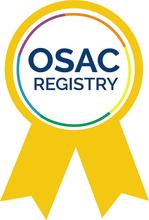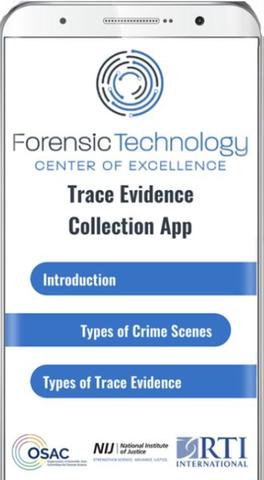November 2023
This Standards Bulletin from the Organization of Scientific Area Committees (OSAC) for Forensic Science provides a monthly update on:
- Standards moving through the OSAC Registry approval processes for published and OSAC Proposed Standards.
- Standards moving through the development process at standards development organizations (SDOs).
Bulletin Summary:
- New standards added to the OSAC Registry: 9
- Standards under consideration for the Registry and open for comment: 4
- New SDO Published Standards: 3
- Standards open for comment at SDOs: 17
OSAC Registry Updates

The OSAC Registry is a repository of selected published and proposed standards for forensic science. These written documents contain minimum requirements, best practices, standard protocols, terminology, or other information to promote valid, reliable, and reproducible forensic results.
The standards on the OSAC Registry have undergone a technical and quality review process that actively encourages feedback from forensic science practitioners, research scientists, human factors experts, statisticians, legal experts and the public.
Nine New Standards Added to the OSAC Registry
5 SDO Published Standards (added November 7, 2023):
- ANSI/ASB Standard 098, Standard for Mass Spectral Analysis in Forensic Toxicology. 2023. 1st. Ed.
- ANSI/ASB Standard 113, Standard for Identification Criteria in Forensic Toxicology. 2023. 1st. Ed.
- ANSI/ASB Best Practice Recommendation 114, Internal Validation of Software used in Forensic DNA Laboratories. 2022. 1st. Ed.
- ANSI/ASB Standard 138, Standard for Collection of Known DNA Samples from Domestic Mammals. 2022. 1st. Ed.
- ANSI/ASB Standard 158, Standard for Developing Standard Operating Procedures in Bloodstain Pattern Analysis. 2023. 1st. Ed.
4 OSAC Proposed Standards (added November 7, 2023):
- OSAC 2021-N-0010, Standard for Skeletal Preparation and Sampling in Forensic Anthropology
- OSAC 2021-S-0003, Standards for Setting Analytical and Stochastic Thresholds for Application to Forensic DNA Casework Using Electrophoresis Platforms.
- OSAC 2023-N-0010, Standard Practice for the Collection of Primer Gunshot Residue (pGSR) Particles from Clothing, Vehicles, and Other Inanimate Objects using Scanning Electron Microscopy (SEM) Stubs
- OSAC 2023-N-0011, Standard Practice for a Physical Fit Analysis Training Program
Standards Open for Comment for OSAC Registry Approval
SDO Published Standards
The OSAC Registry approval process for published standards is used to review existing SDO published standards for technical quality and placement on the Registry. Please submit your comments by 11:59 p.m. ET on December 4, 2023, on whether the following SDO published standards should be included on the Registry:
- ANSI/ASB Standard 153, Standard Practices for Proficiency Testing for Forensic Toxicology Laboratories and Breath Alcohol Programs. 2023. 1st. Ed. Submit your comments here.
- ANSI/ASB Best Practice Recommendation 156, Best Practices for Specimen Collection and Preservation for Forensic Toxicology. 2023. 1st. Ed. Submit your comments here.
OSAC Proposed Standards
The OSAC Registry approval process for OSAC Proposed Standards is used to review OSAC drafted standards for technical quality and placement on the Registry. The following draft OSAC Proposed Standards are being considered for submission to an SDO. The final draft provided to the SDO will be available on the OSAC Registry as an “OSAC Proposed Standard.”
OSAC welcomes comments on whether the current drafts are suitable for release to the SDO as well as suggestions for improvements in content and wording. To be considered, comments must be placed in the OSAC Comment Form and sent to comments [at] nist.gov (comments[at]nist[dot]gov) by 11:59 p.m. ET on December 4, 2023.
- OSAC 2024-S-0001, Guidance Document for Understanding and Implementing the Minimal Components of a Quality Assurance Program in Forensic Anthropology
- OSAC 2024-S-0002, Standard Test Method for the Examination and Comparison of Toolmarks for Source Attribution
Is your organization implementing standards on the OSAC Registry?
Complete OSAC’s Registry Implementation Declaration Form found on the OSAC website and send it to forensics [at] nist.gov (forensics[at]nist[dot]gov) to let us know. Your organization will subsequently be awarded an OSAC Registry Implementer Certificate.
Interested in learning more about implementation? Check out OSAC’s Implementation Recognition Factsheet.
SDO UPDATES
New Published Standards
ASTM recently published the following standards:
- ANSI/ASTM E3175-23, Standard Practice for Training in the Forensic Examination of Hair by Microscopy (revision of ANSI/ASTM E3175-22)
- ANSI/ASTM E3272-23, Standard Guide for Collection of Soils and Other Geological Evidence for Criminal Forensic Applications (revision of ANSI/ASTM E3272-21)
- ANSI/ASTM E3284-23, Practice for Training in the Forensic Examination of Primer Gunshot Residue (pGSR) Using Scanning Electron Microscopy/Energy Dispersive X-Ray Spectrometry (SEM/EDS) (new standard)
Standards Open for Comment at SDOs
Stakeholders from the forensic science community are encouraged to provide input on standards as they are being developed at SDOs. For SDO published standards going through the OSAC Registry approval process, the public will have an opportunity to comment on a standard during the SDO’s public comment period but will not be given a second opportunity to comment through OSAC on whether the resulting standard should be placed on the Registry.
Visit OSAC’s Standards Open for Comment webpage to see the full list of forensic science standards open for comment at SDOs and how to submit your feedback. This page consolidates and tracks comment deadlines for you and will be updated on a weekly basis. It currently includes:
- 3 standards open for comment at ASB in Forensic Toxicology and 14 standards open for comment at SWGDE.
OSAC Program Office News
OSAC Releases a Refreshed Lexicon for the Forensic Sciences!
The OSAC Lexicon was recently refreshed to help bring better consistency and understanding in the way terms are used by the various forensic science disciplines. The OSAC Lexicon now includes:
- OSAC Preferred Terms and definitions
- Terms from standards on the OSAC Registry (both published and OSAC Proposed standards)
- Terms from SDO published standards (irrespective of Registry status)
Read more about the refreshed OSAC Lexicon and take a moment to tour it on the OSAC Lexicon website!
OSAC FSSB Meeting: Public Feedback Session
The OSAC Forensic Science Standards Board (FSSB) will have a public feedback session available during its upcoming quarterly meeting. The purpose for this public session is to provide stakeholders with an opportunity to share feedback with the FSSB related to agenda items or matters within the FSSB’s authority. The FSSB will consider all feedback from the public, and remarks can be made by the submitter or by the OSAC Program Office on behalf of the submitter.
The public session will take place virtually on Thursday, December 14, 2023. If you wish to share feedback with the FSSB, please complete this form by December 1, 2023.
The schedules and agendas for upcoming FSSB meetings can be found on the FSSB Meetings webpage.
Other Forensic Science News, Events, & Training
Technical Working Group for 3D Toolmark Technologies (TWG3D2T) Seeking Public Comments
The TWG3D2T is soliciting public comments on their draft “Best practice guide for the calibration and quality control of 3D surface topography measurement instruments used for Virtual Comparison Microscopy (VCM) of toolmarks.” Please visit www.twg3d2t.org to download the document and public comment form if you’re interested. The public comment period will start on November 1, 2023, and end on November 30, 2023. For more information or help with accessing the files, please email alan.zheng [at] nist.gov (alan[dot]zheng[at]nist[dot]gov).
Check out the latest Trace Evidence Collection App

Please check out the newly updated version of the Trace Evidence Collection App, which is available for free download on both Android and iOS platforms! The Trace Evidence Collection App is intended for use by crime scene investigators to have access to a quick and easy reference for the detection, recognition, collection, and packaging of commonly encountered types of trace evidence at various types of crime scenes. The newest version of the application (released August 2023) contains 19 demonstration videos covering topics from making a druggist fold to collecting primer GSR from hands to packaging questioned glass, and everything in between.
This project was a collaboration between the National Institute of Standards and Technology (NIST), Organization of Scientific Area Committees (OSAC) for Forensic Science), the National Institute of Justice Forensic Technology Center of Excellence (NIJ FTCoE), and independent non-profit research institute RTI International. The app contains information on Types of Crime Scenes (e.g., Arson, Hit & Run) and Types of Trace Evidence (e.g., Fire Debris, Glass). Each Type of Crime Scene section contains an overview, a list of relevant evidence types, and checklists for evidence collection from scene-specific sources (e.g., from victim, from scene/vehicle). Each Type of Trace Evidence section contains an overview, information about detection, recognition, collection, and packaging, as well as demonstration videos. If you have any questions or comments, please contact Daniel Mabel (he/him/his), OSAC Trace Materials Subcommittee Outreach Task Group Chair, at daniel.e.mabel.civ [at] army.mil (daniel[dot]e[dot]mabel[dot]civ[at]army[dot]mil).
The full collection of the mobile app’s demonstration videos are also available for download from the NIST video playlist .
https://forensiccoe.org/trace-evidence-collection-mobile-app/
AAFS Standards Resources and Training
As part of a cooperative agreement with NIST, the American Academy of Forensic Sciences (AAFS) is developing training, tools, and resources to enhance implementation efforts and broaden awareness of forensic science standards among communities of interest.
- Standards factsheets provide a clear, concise, and easy way to understand the purpose of a specific standard, why it is needed, and the benefits of adoption. Standards factsheets are available for 115+ standards on the OSAC Registry.
- Standards checklists are a tool that forensic science service providers can use to track progress towards implementation, identify gaps or barriers to implementation, or document objective evidence of implementation or compliance with a standard. Checklists are available for 110+ standards on the OSAC Registry.
- Standards videos and webinars are available for free from AAFS Connect. Learn about the standards development process, standards development activities in various disciplines, and information about specific SDO published standards on the OSAC Registry.
Upcoming Events
- December 13 - 14: FSSB winter quarterly meeting

